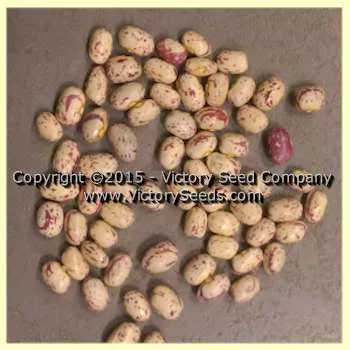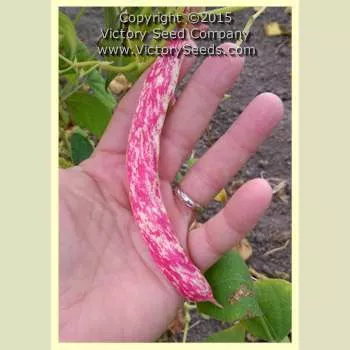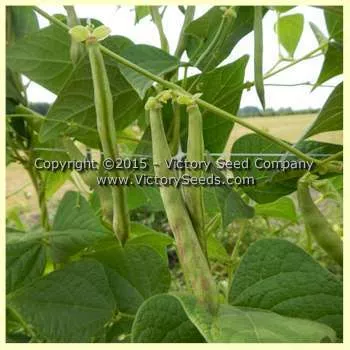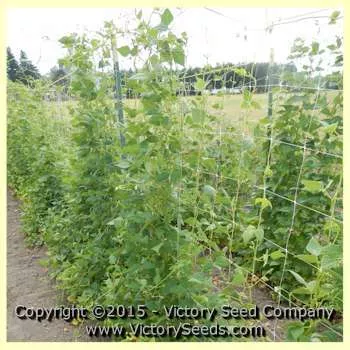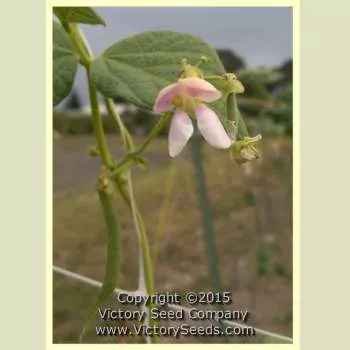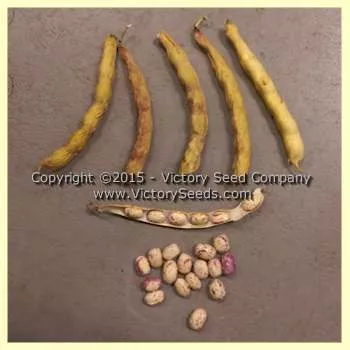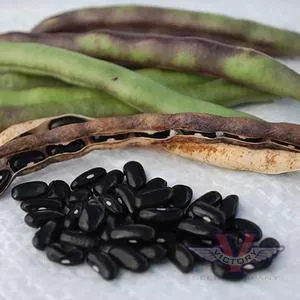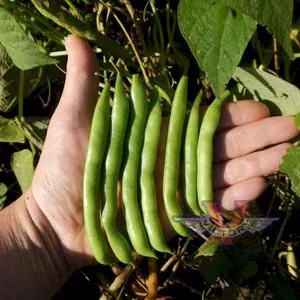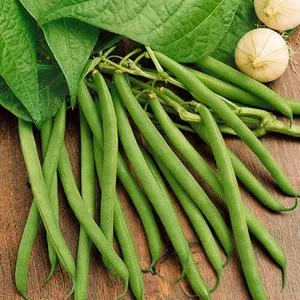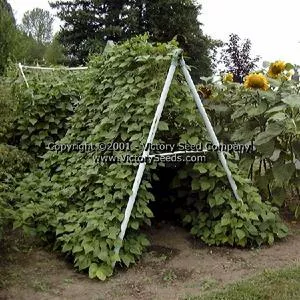





Petaluma Gold Rush Garden Bean
Phaseolus vulgaris
Price: $4.25
SKU: 303132195 days - The vines are vigorous and grow up to about ten feet in height. As the pods fill and mature, the pod color changes from green to a golden yellow mottled with scarlet streaks. The pods reach about five inches in length and are filled with an average of six, plump seeds that are tan with splashes of light-maroon. The dry beans retain their firm texture and meaty, rich flavor in soups, dips, stews and many other recipes that call for dry beans.
The lore now surrounding the 'Petaluma Gold Rush' bean is that it was originally brought to the United States from Peru in 1840 by a member of the Azevedo family. He was of Portuguese decent, departed the Azores as part of a whaler crew, and arriving in San Francisco during the height of the California Gold Rush, jumped ship. He is then said to have taken up farming, eventually moving to the Petaluma area.[1] This story originates from William Woys Weaver's book entitled, "100 Vegetables and Where They Came From," published in 2000.
The founders of the Victory Seed Company, Denise and Mike Dunton, both grew up around Petaluma, California and lived there until 1988. Denise's ancestors date back to the mid-1800s and were among the "Founding Families" of Sonoma County. Even though they grew up there, knew and went to school with Azevedo family members, were gardeners, and were connecting with Sonoma County's agricultural community, they had never heard of this bean.
It wasn't until reading Mr. Weaver's book that they learned about this bean's tantalizing story. Since it was so curious that a hometown heirloom was not something known to them, nor commercialized in the local area, they began searching for a seed sample. Finally located from a commercial source in the Petaluma area, the source of the seed was Mr. Weaver. Grown out, it proved to be a really nice and attractive horticultural-type (multi-use) bean as described above.
The history of 'Petaluma Gold Rush' bean is still undocumented. In attempting to research this variety, we have not been able to find any additional information about it other than Mr. Weaver's published story. All other online references, as well as seed sources, lead back to him. While attempting to follow up on the facts outlined in the original article, we have also not been able to find any corroborating documentary evidence. This search is ongoing, we will explore it further, and will update this web page as new information is available. If you have source information, copies of newspaper or magazine articles prior to the 1990s, we would love to receive copies.
The lore now surrounding the 'Petaluma Gold Rush' bean is that it was originally brought to the United States from Peru in 1840 by a member of the Azevedo family. He was of Portuguese decent, departed the Azores as part of a whaler crew, and arriving in San Francisco during the height of the California Gold Rush, jumped ship. He is then said to have taken up farming, eventually moving to the Petaluma area.[1] This story originates from William Woys Weaver's book entitled, "100 Vegetables and Where They Came From," published in 2000.
The founders of the Victory Seed Company, Denise and Mike Dunton, both grew up around Petaluma, California and lived there until 1988. Denise's ancestors date back to the mid-1800s and were among the "Founding Families" of Sonoma County. Even though they grew up there, knew and went to school with Azevedo family members, were gardeners, and were connecting with Sonoma County's agricultural community, they had never heard of this bean.
It wasn't until reading Mr. Weaver's book that they learned about this bean's tantalizing story. Since it was so curious that a hometown heirloom was not something known to them, nor commercialized in the local area, they began searching for a seed sample. Finally located from a commercial source in the Petaluma area, the source of the seed was Mr. Weaver. Grown out, it proved to be a really nice and attractive horticultural-type (multi-use) bean as described above.
The history of 'Petaluma Gold Rush' bean is still undocumented. In attempting to research this variety, we have not been able to find any additional information about it other than Mr. Weaver's published story. All other online references, as well as seed sources, lead back to him. While attempting to follow up on the facts outlined in the original article, we have also not been able to find any corroborating documentary evidence. This search is ongoing, we will explore it further, and will update this web page as new information is available. If you have source information, copies of newspaper or magazine articles prior to the 1990s, we would love to receive copies.
Genetic Classification: Open Pollinated
Planting Instructions:
Beans prefer well-drained, rich soil in a sunny location. Make sure you keep them well watered in the summer heat.
Beans are a tender vegetable and you should not plant them until all danger of frost has passed and the soil remains above 65ºF. Sow seeds 1-1½ inches deep, every two to three inches. Bush-type beans do not require support.
For seed saving, allow pods to remain on the plant until they are brittle and open easily. However, if you live in an area with a short growing season, harvest as close to dry as possible and finish drying indoors. Rain and freezing temps will damage beans.
Beans prefer well-drained, rich soil in a sunny location. Make sure you keep them well watered in the summer heat.
Beans are a tender vegetable and you should not plant them until all danger of frost has passed and the soil remains above 65ºF. Sow seeds 1-1½ inches deep, every two to three inches. Bush-type beans do not require support.
For seed saving, allow pods to remain on the plant until they are brittle and open easily. However, if you live in an area with a short growing season, harvest as close to dry as possible and finish drying indoors. Rain and freezing temps will damage beans.
Informational References:
- "100 Vegetables and Where They Came From," William Woys Weaver, 2000, pgs. 176-178
Customer Reviews:
Do you have experience with this one? 📝 📣 Write a review!
No reviews have been posted yet.

